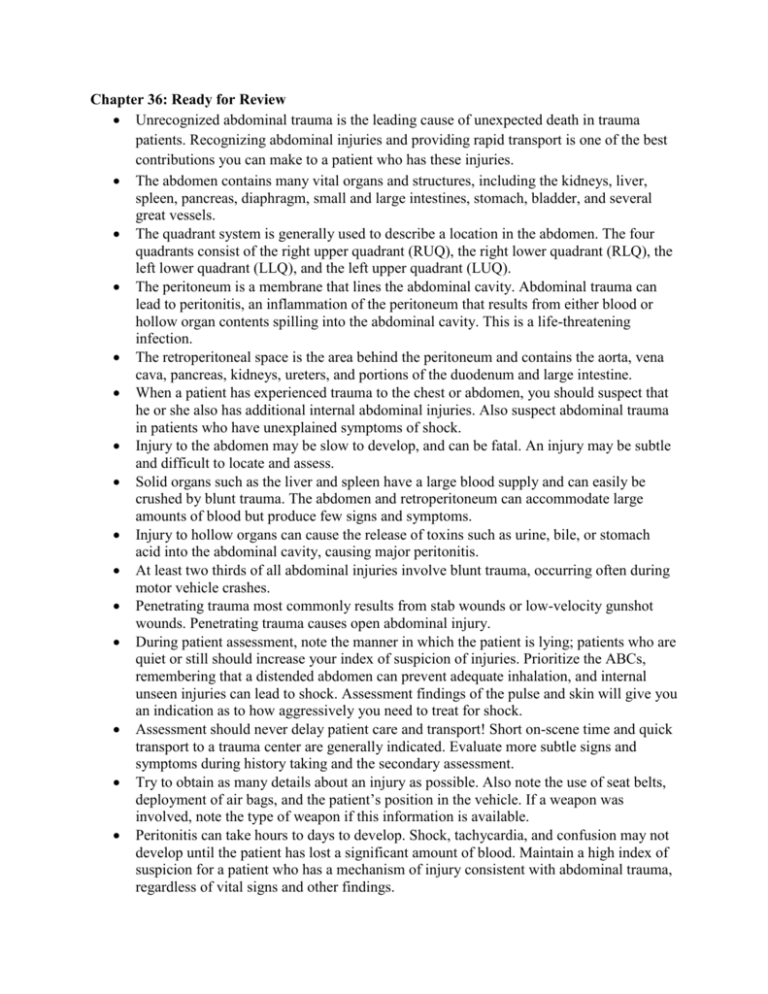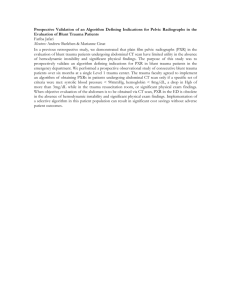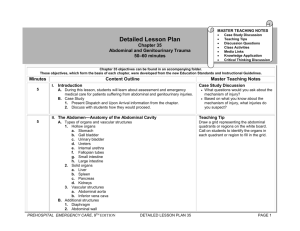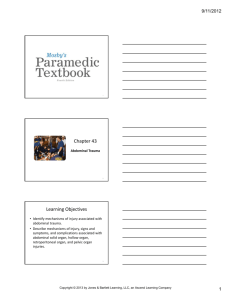Chapter 36: Abdominal and Genitourinary Trauma
advertisement

Chapter 36: Ready for Review Unrecognized abdominal trauma is the leading cause of unexpected death in trauma patients. Recognizing abdominal injuries and providing rapid transport is one of the best contributions you can make to a patient who has these injuries. The abdomen contains many vital organs and structures, including the kidneys, liver, spleen, pancreas, diaphragm, small and large intestines, stomach, bladder, and several great vessels. The quadrant system is generally used to describe a location in the abdomen. The four quadrants consist of the right upper quadrant (RUQ), the right lower quadrant (RLQ), the left lower quadrant (LLQ), and the left upper quadrant (LUQ). The peritoneum is a membrane that lines the abdominal cavity. Abdominal trauma can lead to peritonitis, an inflammation of the peritoneum that results from either blood or hollow organ contents spilling into the abdominal cavity. This is a life-threatening infection. The retroperitoneal space is the area behind the peritoneum and contains the aorta, vena cava, pancreas, kidneys, ureters, and portions of the duodenum and large intestine. When a patient has experienced trauma to the chest or abdomen, you should suspect that he or she also has additional internal abdominal injuries. Also suspect abdominal trauma in patients who have unexplained symptoms of shock. Injury to the abdomen may be slow to develop, and can be fatal. An injury may be subtle and difficult to locate and assess. Solid organs such as the liver and spleen have a large blood supply and can easily be crushed by blunt trauma. The abdomen and retroperitoneum can accommodate large amounts of blood but produce few signs and symptoms. Injury to hollow organs can cause the release of toxins such as urine, bile, or stomach acid into the abdominal cavity, causing major peritonitis. At least two thirds of all abdominal injuries involve blunt trauma, occurring often during motor vehicle crashes. Penetrating trauma most commonly results from stab wounds or low-velocity gunshot wounds. Penetrating trauma causes open abdominal injury. During patient assessment, note the manner in which the patient is lying; patients who are quiet or still should increase your index of suspicion of injuries. Prioritize the ABCs, remembering that a distended abdomen can prevent adequate inhalation, and internal unseen injuries can lead to shock. Assessment findings of the pulse and skin will give you an indication as to how aggressively you need to treat for shock. Assessment should never delay patient care and transport! Short on-scene time and quick transport to a trauma center are generally indicated. Evaluate more subtle signs and symptoms during history taking and the secondary assessment. Try to obtain as many details about an injury as possible. Also note the use of seat belts, deployment of air bags, and the patient’s position in the vehicle. If a weapon was involved, note the type of weapon if this information is available. Peritonitis can take hours to days to develop. Shock, tachycardia, and confusion may not develop until the patient has lost a significant amount of blood. Maintain a high index of suspicion for a patient who has a mechanism of injury consistent with abdominal trauma, regardless of vital signs and other findings. Generally, management of patients with abdominal trauma is straightforward: o Ensure a secure airway. o Establish intravenous access and fluid replacement without delaying transport. o Minimize hemorrhaging with pressure dressings. o Apply a cardiac monitor and oxygen therapy, and then transport. • Kidney trauma can cause flank pain and hematuria. Management is the same as for other types of abdominal trauma. • Suspect a bladder injury in any patient who has trauma to the lower abdomen or pelvis. Symptoms include inability to urinate, blood at the urethral opening, and tenderness of the suprapubic region. Management follows basic trauma principles. • Blunt trauma to the testicles can cause painful hematomas, testicular rupture, or testicular torsion. The scrotum may be tender and swollen. Lacerations or avulsions should be treated with gentle compression and ice packs. • Blunt trauma to the penis can cause a large hematoma and pain. Management follows basic trauma principles. • Vaginal trauma can cause hematomas and ecchy moses in the lower pelvic area and on the external female genitalia, bleeding from the vagina, and tenderness on palpation of the lower pelvis. Pelvic fractures can result in damage to the major vascular structures, which can cause life threatening hemorrhage. Because of the forces required to break the pelvis, if the patient has a pelvic fracture, suspect multisystem trauma.











